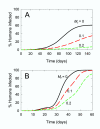Zooprophylaxis or zoopotentiation: the outcome of introducing animals on vector transmission is highly dependent on the mosquito mortality while searching
- PMID: 14565850
- PMCID: PMC222927
- DOI: 10.1186/1475-2875-2-32
Zooprophylaxis or zoopotentiation: the outcome of introducing animals on vector transmission is highly dependent on the mosquito mortality while searching
Abstract
Background: Zooprophylaxis, the diversion of disease carrying insects from humans to animals, may reduce transmission of diseases such as malaria. However, as the number of animals increases, improved availability of blood meals may increase mosquito survival, thereby countering the impact of diverting feeds.
Methods: Computer simulation was used to examine the effects of animals on the transmission of human diseases by mosquitoes. Three scenarios were modelled: (1) endemic transmission, where the animals cannot be infected, eg. malaria; (2) epidemic transmission, where the animals cannot be infected but humans remain susceptible, e.g. malaria; (3) epidemic disease, where both humans and animals can be infected, but develop sterile immunity, eg. Japanese encephalitis B. For each, the passive impact of animals as well as the use of animals as bait to attract mosquitoes to insecticide was examined. The computer programmes are available from the author. A teaching model accompanies this article.
Results: For endemic and epidemic malaria with significant searching-associated vector mortality, changing animal numbers and accessibility had little impact. Changing the accessibility of the humans had a much greater effect. For diseases with an animal amplification cycle, the most critical factor was the proximity of the animals to the mosquito breeding sites.
Conclusion: Estimates of searching-associated vector mortality are essential before the effects of changing animal husbandry practices can be predicted. With realistic values of searching-associated vector mortality rates, zooprophylaxis may be ineffective. However, use of animals as bait to attract mosquitoes to insecticide is predicted to be a promising strategy.
Figures









References
-
- Macdonald G. The epidemiology and control of malaria. London: Oxford University Press; 1957.
-
- Service MW. Mosquito ecology: Field sampling Methods. London: Applied Science Publishers; 1976.
-
- WHO Manual on environmental management for mosquito control with special emphasis on mosquito vectors WHO offset publication No 66 Geneva, Sw: WHO. 1982. - PubMed
-
- Ault SK. Environmental management: a re-emerging vector control strategy. Am J Trop MedHyg. 1994;50:35–49. - PubMed
-
- Bruce-Chwatt LJ. Essential Malariology. second. London: Heinemann; 1985.
Publication types
MeSH terms
LinkOut - more resources
Full Text Sources
Medical

